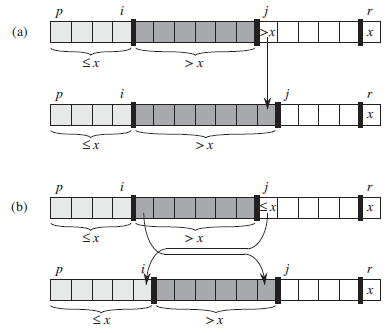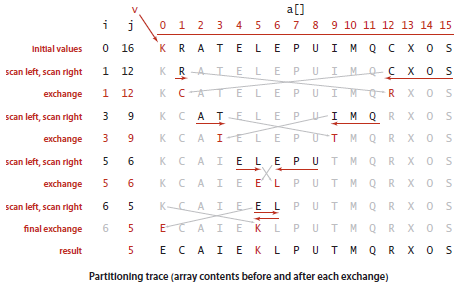Quick sort is a widely applied sorting algorithm in the industry. It is a simple but very powerful algorithm that we should definetely understand. An interesting graph shown below can illustrate the process of this algorithm.

QuickSort
Implementation
def QUICKSORT(A, p, r):
if p < r:
q = PARTITION(A, p, r)
QUICKSORT(A, p, q-1)
QUICKSORT(A, q+1, r)Partition
- Output: elements in the left is less than pivot (p), in the right is larger than pivot (p).
- Each time, put elements <= p in the left >= in the right
- Exchange the partition value and pivot
def PARTITION(A, lo, hi):
# pivot p = A[hi]
p = A[hi]
i = lo - 1
for j in range(lo, hi-1):
if A[j] <= p:
i = i + 1
A[i], A[j] = A[j], A[i]
A[i+1], A[hi] = A[hi], A[i+1]
return i+1- Two cases for iteration of procedure PARTITION

1537942239896
Another Approach
private static int partition(int[] A, int lo, int hi) {
int i = li, j = hi;
// pivot p = A[lo]
int p = A[lo];
while (true) {
while (A[++i] < p) if (i == hi) break;
while (p < A[--j]) if (j == lo) break;
if (i >= j) break;
exch(A, i, j);
}
// exchange the pivot with the partition value
exch(A, lo, j);
return j;
}
1537971744419
Analysis
Worst Case
- each element is larger or smaller than the pivot
\[ \begin{array}{l} T( n) \ =\ T( n-1) \ +\ T( 0) \ +\ \theta ( n)\\ =\ T( n-1) \ +\ \theta ( n)\\ =\ \theta \left( n^{2}\right) \end{array} \]
Best Case
- Partition produces two equal subproblems, each of size no more than n/2
\[ T( n) = 2T( n-1) + \theta( n) = \theta( n) \]
Expected Running Time
First of all, when we pick the pivot, we perform \(n-1\) comparisions.
Then, depending on the pivot, we might split the array into a LESS of size 0 and a GREATER of size \(n-1\); LESS of size 1 and a GREATER of size \(n-2\). All of these are equally likely with probability \(1/n\) each.
\[ T( n) \ =\ ( n-1) \ +\ \frac{1}{n}\sum ^{n-1}_{i=0}( T( i) +T( n-i-1)) \]
\[ T( n) \ =\ ( n-1) \ +\ \frac{2}{n} \ \sum ^{n-1}_{i=0} T( i) \]
Then we apply induction hypothesis, we assume \(T( n) \ \leqslant \ n \lg n\)
\[ \begin{array}{l} \because \sum ^{n-1}_{i=0} T( i) \ \leqslant \ \int ^{n}_{1} T( x) dx\\\\ \therefore T( n) \ \leqslant \ ( n-1) \ +\ \frac{2}{n}\sum ^{n-1}_{i=1}( ci\lg i)\\\\\ \leqslant ( n-1) +\frac{2}{n}\int ^{n}_{1}( cx\lg x) dx\\\\\ =( n-1) +\frac{2c}{n}\left(\frac{1}{2} n^{2}\lg n-\frac{1}{4} n^{2} +\frac{1}{4}\right)\\\\ \leqslant cn\lg n,\ for\ c\ =\ 2. \end{array} \]